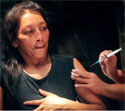 |
 |
 |
Project - Medical Computer Records |
 |
|
WINGS Computer Records
sponsored through Wingsguate.org
Read the about the purchase and implementation of the equipment.
Read how the training and the crop season benefited from this program.
 Guatemala is in the midst of a population explosion in terms of number of individuals of reproductive age. Today, WINGS' mission is to provide quality reproductive health education and services to underserved, primarily rural Guatemalan youth, women, and men. WINGS envisions a future where all Guatemalans thrive and are able to fully exercise their sexual and reproductive rights. Guatemala is in the midst of a population explosion in terms of number of individuals of reproductive age. Today, WINGS' mission is to provide quality reproductive health education and services to underserved, primarily rural Guatemalan youth, women, and men. WINGS envisions a future where all Guatemalans thrive and are able to fully exercise their sexual and reproductive rights.
One of WINGS' longest-standing programs is a network of roughly 30 Volunteer Health Promoters: community leaders identified within underserved rural areas to be a local point of service. Through their intimate linguistic and cultural knowledge of the communities they serve, they are able to provide quality contraceptive counseling, low-cost short-acting methods (three-month injections, one-month injections, birth control pills, and condoms), and referrals to WINGS medical clinics for additional services.
 In mid-2019, service coverage grew from 11 departments to 14, increasing the clinical services team to an entirely new area of Guatemala, the Western Highlands. With the growing patient caseload, which will continue to increase the years ahead, there is a growing need for a successful implementation of a new electronic medical record system.
In mid-2019, service coverage grew from 11 departments to 14, increasing the clinical services team to an entirely new area of Guatemala, the Western Highlands. With the growing patient caseload, which will continue to increase the years ahead, there is a growing need for a successful implementation of a new electronic medical record system.
 This grant will allow for the purchase of seven new computer systems to begin to implement a mobile electronic medical records
application at the permanent clinical site in Antigua and for the mobile medical units in the field. This would help replace the patient record database as well as paper medical records for every client encounter the nurses and doctors have. The Monitoring & Evaluation team has designed a cloud-based app to allow the medical providers to more efficiently capture patient
data and allow for easier data queries and decision making in the field. These first seven
systems have been identified as priority and will be the first step in transitioning to institutional
electronic medical recording.
This grant will allow for the purchase of seven new computer systems to begin to implement a mobile electronic medical records
application at the permanent clinical site in Antigua and for the mobile medical units in the field. This would help replace the patient record database as well as paper medical records for every client encounter the nurses and doctors have. The Monitoring & Evaluation team has designed a cloud-based app to allow the medical providers to more efficiently capture patient
data and allow for easier data queries and decision making in the field. These first seven
systems have been identified as priority and will be the first step in transitioning to institutional
electronic medical recording.
|
|
|